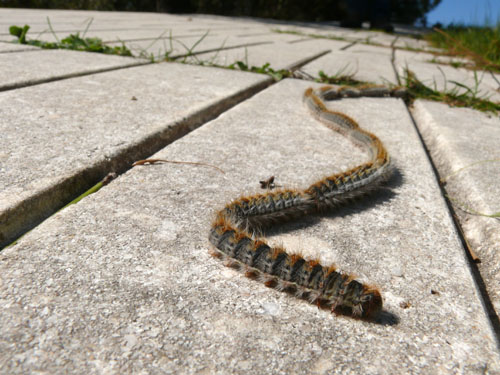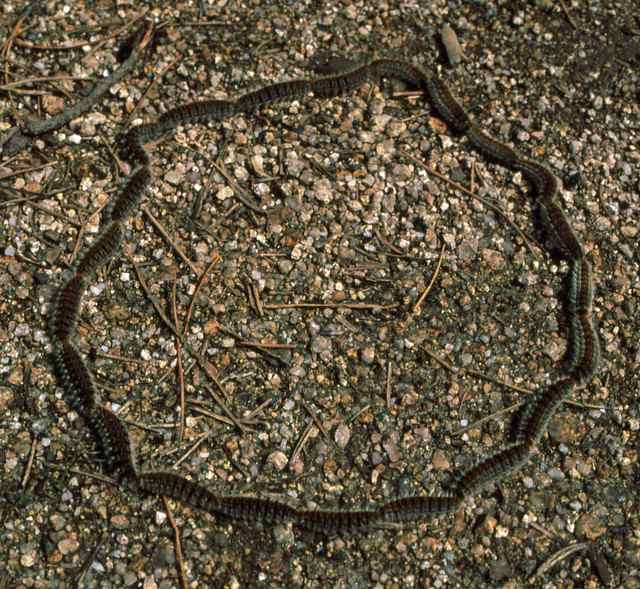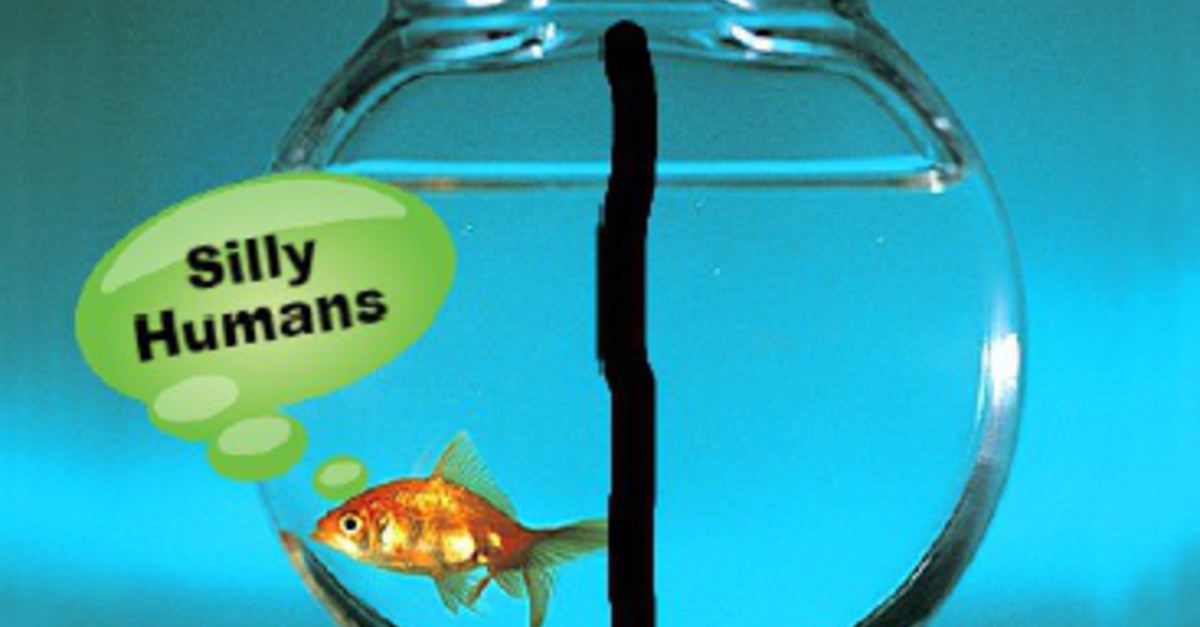Caterpillar example
 Take a caterpillar, for example. What is it like to be a caterpillar? We cannot answer this for sure, but it is very likely that caterpillars have no free choice; instead they are directed by chemical signals both internally (hormones) and externally (food scent etc).
Take a caterpillar, for example. What is it like to be a caterpillar? We cannot answer this for sure, but it is very likely that caterpillars have no free choice; instead they are directed by chemical signals both internally (hormones) and externally (food scent etc).
I recently saw a row of caterpillars lined up like a rope. Luckily, I didn’t touch any, as it turns out they are highly poisonous. But they were following each other head to tail – they are called Processionary caterpillars for a reason.
 Why do they do this? Well, the leading caterpillar sends out a scent from its behind, and the next caterpillar just follows it like a zombie. This helps give them the appearance of a snake to protect themselves from predators. But they had no conscious choice in this decision to follow. In fact, if these caterpillars are placed in a circle, head to tail, they will follow each other around in a circle endlessly until they starve to death – interesting what scientists find out.
Why do they do this? Well, the leading caterpillar sends out a scent from its behind, and the next caterpillar just follows it like a zombie. This helps give them the appearance of a snake to protect themselves from predators. But they had no conscious choice in this decision to follow. In fact, if these caterpillars are placed in a circle, head to tail, they will follow each other around in a circle endlessly until they starve to death – interesting what scientists find out.
What does all this have to do with golf?
I am getting there.
The way that we learn has many similarities with most animals. One of the major functions of our brain is to make links, or associations. A famous scientist, B.F. Skinner, once did an experiment with pigeons. He placed them on a table and rewarded them for certain behaviours.
He also did another experiment where he put pigeons in a box, and gave them rewards randomly. He left them for a few days and came back – the pigeons were insane. They were doing incredibly complex ticks, head bobs, circles, looks over their shoulder etc. in ordered patterns.
It seems as though the pigeons had maybe looked over its shoulder, and then a random food reward came. Subconsciously the pigeon had associated this look over its shoulder with reward and so repeated it. But after a while of no rewards coming, the pigeon added more and more complex behaviours, believing that it was influencing the random rewards.
But surely we humans are not stupid enough for this. Think again. Derren Brown, a famous British mentalist, conducted an experiment where he locked a few people in a room full of bean bags, tables, coloured circles on the floor and other miscellaneous items. There was also a counter on the wall above the door, and a sign saying:
"When you reach 100 points, the doors will be unlocked and you will be free to go"
They all looked confused as there were no rules for how to create points. One guy picked up a bean bag to look at it and put it down, before noticing that the points counter now read 1. So he tried it again, but to no avail. Then someone across the room sat down, and the points counter went up again. So now they tried to pick up a bean bag, and sit down at the other side of the room… bingo, the points went up again.
After about half an hour, you see a bunch of people picking up, putting down, sitting on, moving around bean bags, chairs, tables and other items like madmen. Finally the counter reaches 100 and they are set free.
The Answer
 Being interviewed afterwards, it seemed like every person had ‘figured it out’. They all had some sort of idea for how the points were created. But then the real answer was revealed to them.
Being interviewed afterwards, it seemed like every person had ‘figured it out’. They all had some sort of idea for how the points were created. But then the real answer was revealed to them.
An aquarium in another room had a black line drawn down the middle. Whenever the fish randomly crossed the line, the counter would go up one. The people and their actions had absolutely nothing to do with the points, but every one of them thought that their ‘rules’ for the game were correct. You can watch video about this experiment here.
This associative learning served us very well in the past. Associating hot stoves with pain, smells with experiences, roars with danger etc was advantageous to our survival. But sometimes these associations go wrong and we make false links, like the pigeons and the people in the experiment.
These links and associations become more frequent when a high stress situation occurs, and/or high task difficulty, and also when the reasons for failure are unknown. Baseball players are renowned for being superstitions, with lots of weird movements and routines taken before they perform. And what is more ‘task difficult’ than golf – probably the hardest game in the world.
False Correlation
You could be doing yourself more of a disservice by making these constant links unchecked. I have seen so many weird swings and quirky movements from amateurs. When questioned about them, they usually reply that they had a good round or hit a good shot ‘trying this/that’ and then tried to do more of it. More often than not, it is the thing we then work on eliminating from their technique, as it was never the reason for their success in the first place and is now causing problems.
A real scientist knows that correlation does not equal causation, in other words, just because someone does something and gets a certain result, doesn’t mean that doing that same ‘something’ will give you the same result. For example, long hitters tend to have a very big X factor (difference between hip and shoulder turn), but getting a big X factor does not mean you hit the ball longer. In lots of cases it can actually do the reverse.
The Lessson
 Don’t be a skinner box pigeon. Don’t be one of those guys on the range searching for the secret and making false links left, right and center.
Don’t be a skinner box pigeon. Don’t be one of those guys on the range searching for the secret and making false links left, right and center.
Learn about the Ball Flight Laws, so that you know exactly what is causing what. Then go and see your qualified teacher who can direct you to make better associative links. Your teacher is your path to success. Left alone, you will probably spin in circles making false links as you get those random rewards of occasional good shots. But your teacher can set you on a clear and guided path, as they know what it takes to improve and they are masters at guiding people – they live it.
And remember, there is no secret to golf. Some have claimed it (Hogan and Moe Norman), but usually those guys have had a good 20-80,000 hours of practice. If you are constantly searching for the secret, you will end up like most people – spinning your wheels year after year with constant quick fixes and placebos swing thoughts. If there is any secret at all, its basic fundamentals, a good concept of how to hit the ball, an understanding of ball flight laws and then around 10-20 thousand hours of practice. I’m sure you will find the secret then, just try not to be a pigeon along the way.
If you found this article informative, please spend a quick second to share on facebook or twitter. Also, click below to join my facebook page and twitter. And, as promised, here is the video of humans acting like skinner box pigeons

